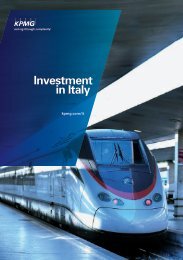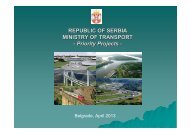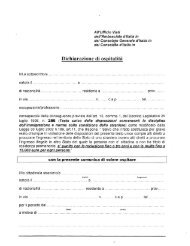Innovation Canada: A Call to Action
Innovation Canada: A Call to Action
Innovation Canada: A Call to Action
Create successful ePaper yourself
Turn your PDF publications into a flip-book with our unique Google optimized e-Paper software.
<strong>Innovation</strong> <strong>Canada</strong>: A <strong>Call</strong> <strong>to</strong> <strong>Action</strong>instruments can develop constituencies ofsupport and a degree of au<strong>to</strong>nomy, makingthem less amenable <strong>to</strong> change or cancellation,even where this would be sensible. In somecases, there may be ways <strong>to</strong> streamline therange of instruments and programmes, reducecomplexity, enhance transparency and loweradministration costs” (OECD forthcoming, p. 9).Internationally, jurisdictions such as Finland andthe UK, and domestically both Alberta andOntario, have reduced the number of businessinnovation programs offered and haverationalized their program suites in<strong>to</strong> a set ofmutually exclusive programs, thus providingcoverage for areas of government interventionin the innovation system. The UK governmenthas consolidated its business support programs,reducing their number very substantially in thenew Solutions for Business program launched inApril 2011. The Panel believes that thegovernment must seize opportunities forprogram consolidation, and thereforerecommends the following.1.5 Program consolidation — Over time,consolidate business innovation programsfocussed on similar outcome areas in<strong>to</strong> asmaller number of larger, more flexibleprograms open <strong>to</strong> a broader range ofapplicants and approaches.Through a more streamlined suite of programs,the government could reduce overhead costs,increase impact, enhance client awareness andimprove the usability of business innovationprograms.Comparative Program EvaluationThe Panel was asked <strong>to</strong> provide advice onwhich federal programs in support of businessinnovation are most effective. However, asnoted earlier, the <strong>to</strong>ols needed <strong>to</strong> assesscomparative effectiveness have not yet beendeveloped — there is no agreed-upondefinition, framework or methodology forcomparative evaluation, no commonperformance indica<strong>to</strong>rs and no commondatabase of the programs. Management of$1.5 billion in direct program spending requiresbetter management <strong>to</strong>ols <strong>to</strong> be put in place,<strong>to</strong>gether with a process <strong>to</strong> apply these <strong>to</strong>ols ina comprehensive, consistent and ongoing way.A common, outcomes-focussed framework forperformance management and publicevaluation of business and commerciallyrelevant R&D programs would improvecomparability among programs and informdecisions <strong>to</strong> reallocate funding strategicallywithin the overall portfolio. It would make<strong>Canada</strong> a leader in managing for results.Accordingly, the Panel recommends thefollowing.1.6 Program evaluation — Build a federalcapacity <strong>to</strong> assess the effectiveness of newand existing business innovation programs<strong>to</strong> enable comparative performanceevaluation and <strong>to</strong> guide resource allocationgoing forward.To this end, it is possible <strong>to</strong> conceive of a wholeof-governmentevaluation approach wherebysets of “intermediate outcomes” are applied asperformance measures <strong>to</strong> categories of likeforms of support, regardless of the departmen<strong>to</strong>r agency providing that support. A schematicexample of this approach is illustrated inFigure 5.6, which could potentially serve as abasis for discussion between the IRIC and thefederal evaluation community, working withthe Treasury Board Secretariat.5-16
















